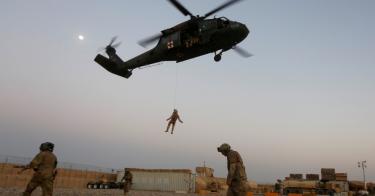Afghanistan is back in the news. Wednesday, 2 U.S. servicemembers were killing in a suicide bombing attack. Already this year, U.S. airstrikes are at their highest level since 2012, and President Trump is considering sending up to 3,000 more troops to support the 8,400 Americans already serving there.
Why does the AfPak region remain a hotbed of terrorist plotting and violence? General John W. Nicholson, commander of U.S. and NATO forces in Afghanistan, notes that of the 98 designated terrorist organizations around the globe, 20 of them operate in the region. It’s an exceptional concentration, and just one reason why the U.S. must remain engaged in Afghanistan.
Yet for some years now, voices on both the right and left have urged American withdrawal. That would be a mistake. As America and its allies have drawn down troops in Afghanistan, Al Qaeda has been quietly strengthening its hand.
The terrorist group has proved adept at retaining allies in the region, then working alongside them to strengthen the terrorist movement as a whole. Let’s focus on just three of these allies.
First, there is the Taliban. Many in the West believe they can be peeled off from Al Qaeda at the negotiating table. That seems highly unlikely. Despite multiple changes of leadership, the two groups have reaffirmed allegiance to each other after every change. It’s not just talk. The two continue to work together militarily.
Al Qaeda also retains its ties to the Haqqani network (HQN). In the immediate aftermath of the allied invasion of Afghanistan, the AfPak insurgent group helped al-Qaeda establish itself in Pakistani tribal areas. The groups continue to work hand-in-glove.
Intelligence officials recently told Fox News that Al Qaeda “provides fighters, expertise and material support to HQN when needed … and several times its members have participated in joint operations with the Taliban and HQN.” Indeed, a senior HQN leader has commented that there “is no distinction between us [and Al Qaeda]… we are all one.”
Then there is Tehrik-i-Taliban Pakistan (TTP). Formed in December 2007, it’s an umbrella group drawing terrorists from various Pashtun Pakistani groups. TTP provided the training to Faisal Shahzad, the Times Square bomber. Back then CIA Director John Brennan noted that TTP and AQ ‘train together, they plan together, they plot together. They are almost indistinguishable.’
That remains true. TTP publicly confirmed that senior al-Qaeda leaders such as Qari Muhammad Yasin – killed in an air strike in March 2017 – worked closely with their group up until the time of his death.
In addition forging alliances in Afghanistan, Al-Qaeda still uses it as a training base--most notably for its newest affiliate, Al Qaeda in the Indian Subcontinent (AQIS).
Terrorism expert Bill Roggio says AQIS has likely drawn members from al-Qaeda allies such as TTP, Harakat-ul-Muhajideen, Jaish-e-Mohammad, Lashkar-e-Jhangvi and the Islamic Movement of Uzbekistan. AQIS is a regional threat, focused on carrying out attacks on military targets in Bangladesh, Burma, India and Pakistan.
In October 2015, the U.S. launched “one of the largest joint ground-assault operations we have ever conducted in Afghanistan.” The target: two AQIS training camps that, in total, covered around 30 square miles. The U.S. commander said it was “probably the largest” Al Qaeda training camp found since the war began.
That such a training camp could exist in 2015 speaks to a broader problem of the U.S. consistently underestimating Al Qaeda’s strength. Last year, the U.S. killed or captured 250 Al Qaeda figures. Thomas Joscelyn, a leading expert on al-Qaeda points out, “This was two and half times the American government’s long-held, high-end estimate for Al Qaeda’s entire presence in the country.”
Underestimating Al Qaeda in Afghanistan had devastating consequences on 9/11. We cannot make the same mistake again. The ongoing terrorist threat emanating from Afghanistan remains a compelling reason for the U.S. to remain committed to the fight there. (And I have not even discussed ISIS, which has its own affiliate in the country).
Unfortunately, the Afghan security forces are not yet trained to such a standard that they can execute this vital counter-terrorism task alone. So the nature of the Western commitment must involve troops – not just from the U.S., but across NATO. These troops will not be able to transform Afghanistan into a paragon of democracy and liberty, nor should they try to.
But additional troops will be able to help maintain security in a country rife with terrorist groups that still pose a very clear danger to innocent lives around the world.
This piece originally appeared in FoxNews



